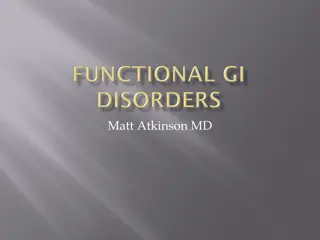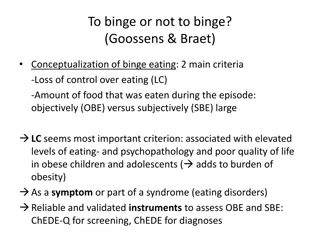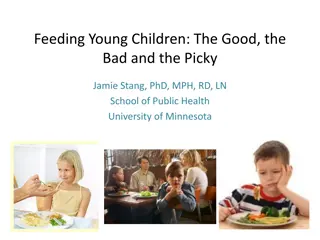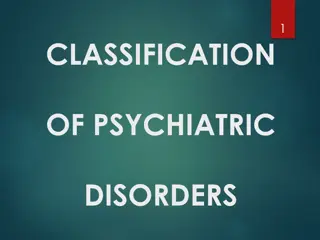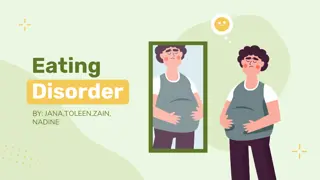EXERCISE ADDICTION AND DISORDERED EATING IN ADOLESCENTS
A study led by Dr. Mia Beck Lichtenstein introduces the Exercise Addiction Inventory for Youth (EAI-Y) to assess exercise addiction in adolescents, particularly those with disordered eating. The research aimed to validate the EAI-Y, estimate the prevalence of exercise addiction in active adolescents
2 views • 10 slides
Somatic Symptom Disorders, Conversion Disorders, and Dissociative Disorders
Somatic symptom disorders manifest as physical symptoms without apparent cause, while conversion disorders involve specific physical symptoms incompatible with medical conditions. Illness anxiety disorder involves interpreting normal sensations as disease symptoms. Dissociative disorders lead to a s
3 views • 41 slides
Essential Meal Support Training for Caregivers of Individuals with Eating Disorders
Comprehensive meal support training program for caregivers of individuals with eating disorders. Contributors include professionals in psychology, dietetics, and psychiatry. Covered topics include treatment basics, family-based approaches, caregiver expectations, and modeling healthy eating behavior
0 views • 56 slides
Eating Disorders in Older Adults
Eating disorders can affect older adults too, yet they are often overlooked or misdiagnosed. Challenges in diagnosing these disorders arise from various underlying health conditions. Types of eating disorders include anorexia nervosa, bulimia nervosa, binge eating disorder, and others. Recognizing c
0 views • 7 slides
Functional GI Disorders: A Comprehensive Overview
Functional GI disorders encompass a range of conditions affecting the gastrointestinal system, such as irritable bowel syndrome and disorders of the gut-brain interaction. These disorders are characterized by no structural abnormalities but are influenced by factors like motility disturbance, viscer
1 views • 42 slides
Eating Disorders: Types, Signs, Effects, and Recovery
Eating disorders are mental disorders characterized by unhealthy eating habits and can have severe physical and psychological consequences. This article explores the definition of eating disorders, signs to look out for, different types such as Anorexia Nervosa, Bulimia Nervosa, Pica, and Purging Di
1 views • 10 slides
Eating Disorders in Children and Adolescents: Insights from Dr. Irene Yi
This comprehensive presentation by Dr. Irene Yi delves into eating disorders, including Anorexia Nervosa and Bulimia, in children and adolescents. The content covers types of eating disorders, developmental perspectives, assessment stages, and management strategies. NICE guidelines for managing eati
0 views • 25 slides
Eating Disorders: Types, Signs, and Recovery
Eating disorders are mental disorders characterized by unusual eating habits that can negatively impact physical and mental health. They manifest in various forms such as anorexia nervosa, bulimia nervosa, pica, and purging disorder. Recognizing signs like changes in weight, body image obsession, an
0 views • 6 slides
Eating Disorders in Older Adults
Eating disorders in older adults can have serious physical and mental health consequences. Recognizing symptoms such as weight loss, phobia, and vomiting is crucial. Treatment is available, and it's important to differentiate between eating disorders and other causes of weight loss in older adults t
0 views • 10 slides
Eating Disorders: Insights and Treatments
Body dissatisfaction is prevalent in both men and women, leading to the development of eating disorders like anorexia nervosa and bulimia nervosa. Anorexia nervosa is characterized by restricted food intake and intense fear of weight gain, while bulimia nervosa involves binge eating and purging beha
0 views • 13 slides
Eating Disorders: Insights for Dietitians
Eating disorders are complex neurobiological conditions that are not merely about control or weight management. These disorders can affect individuals of all genders, body sizes, and socioeconomic backgrounds. Dietitians play a crucial role in identifying, assessing, and treating eating disorders, a
0 views • 41 slides
Eating Disorders in Children by Dr. Soumi Kundu
Eating disorders in children, such as anorexia nervosa, bulimia nervosa, and binge eating disorder, are complex biopsychosocial disorders characterized by dysfunctional patterns of cognition and weight control behaviors. They result in significant physical, psychological, and social complications. T
0 views • 34 slides
Eating Disorders: An Overview from University of Basra College of Nursing
Eating disorders have a long history, with anorexia nervosa established as a mental disorder in the 1960s and bulimia nervosa described later. These disorders can be viewed on a continuum, with anorexia, bulimia, and obesity at different ends. Anorexia nervosa is characterized by restrictive behavio
0 views • 30 slides
Eating Disorders: Medical Complications and Treatment
This presentation by Dr. Maria C. Monge covers the common eating disorders in teenage patients, potential medical complications, and the role of the medical team in treatment. It includes definitions of disorders like Anorexia Nervosa, Bulimia Nervosa, and Binge Eating Disorder according to DSM-5 cr
2 views • 60 slides
Binge Eating in Children and Adolescents: Implications for Obesity Practitioners
Conceptualizing binge eating in young individuals involves criteria like loss of control over eating and the amount of food consumed. The prevalence of binge eating varies based on definitions and assessment methods, with non-treatment seekers showing lower rates than treatment seekers. The developm
1 views • 5 slides
Eating Disorders: Types, Signs, and Support
Eating disorders encompass unhealthy attitudes towards food and body image, affecting individuals' physical and mental well-being. Types such as anorexia nervosa, bulimia, binge eating disorder, and OSFED are discussed, along with the emotional aspects of these conditions. Recognizing signs, seeking
0 views • 45 slides
Tertiary Care for Eating Disorders Presentation
This presentation covers various aspects of tertiary care for eating disorders, providing valuable information and insights on the topic. It includes slides on treatment approaches, challenges, and the importance of specialized care in managing eating disorders effectively.
0 views • 8 slides
Impact of Chronotype on Developing Eating Disorders
Chronotypes, representing individuals' morningness-eveningness preference, play a significant role in the propensity to develop eating disorders. Evening chronotypes, facing a mismatch between their internal clock and societal demands, have been linked to various health and mental health issues. A s
0 views • 5 slides
Recognizing and Managing the Female Athlete Triad: Coaches' Role
The Female Athlete Triad encompasses disordered eating, amenorrhea, and osteoporosis. Coaches play a vital role in recognizing and addressing disordered eating in athletes. This condition ranges from simple dieting to clinical eating disorders, impacting performance and health. Understanding the sig
1 views • 9 slides
Addressing Insurance Barriers in Eating Disorder Treatment: A Call for Change
Kentucky faces significant challenges in providing adequate care for individuals with eating disorders due to insurance barriers, lack of trained professionals, and limited treatment options within the state. The high mortality rate, chronic nature, and costly treatment of eating disorders exacerbat
0 views • 28 slides
Comprehensive Management Guidelines for Pediatric Eating Disorders
This comprehensive guide covers the management of children and young persons with eating disorders, focusing on anxiety, confusion, knowledge, and skill development. It emphasizes the partnership between pediatricians and psychiatrists, specific medical and nutritional aspects, adequate support, and
0 views • 29 slides
Teen Body Image and Eating Disorders
Explore the complexities of body image among young adults, its positive and negative impacts, and common concerns such as weight, eating disorders, and cultural influences. Learn about the connection between negative body image and the development of eating disorders, and discover resources for supp
0 views • 45 slides
Sleep Disorders: Classification and Diagnosis
Sleep disorders encompass various conditions affecting sleep patterns and quality. They are classified into categories such as insomnia, sleep-related breathing disorders, central disorders of hypersomnolence, circadian rhythm sleep-wake disorders, parasomnias, and sleep-related movement disorders.
0 views • 32 slides
The Female Athlete Triad: Disordered Eating, Amenorrhea, Osteoporosis
The Female Athlete Triad encompasses disordered eating, amenorrhea, and osteoporosis, posing serious risks to athletes. Disordered eating behaviors range from simple dieting to clinical eating disorders, impacting the athlete's health and performance. Coaches play a crucial role in recognizing signs
0 views • 10 slides
Children's Eating Behavior and Taste Preferences
This presentation delves into common eating behaviors and challenges in young children, including the development of taste preferences. It highlights the impact of prenatal and early childhood exposures on food acceptance, discusses the role of parental feeding practices, and emphasizes the importan
0 views • 27 slides
Eating Disorders: Key Insights from Dr. James R. Kirkpatrick, MD
Dr. James R. Kirkpatrick, MD, a renowned expert in eating disorders, shares valuable insights in a webinar presentation. He emphasizes the importance of taking a detailed eating disorder history, provides reasons for initial interviews, and highlights motivations for engaging in eating disorders. Th
0 views • 79 slides
Eating Disorders: Overview, Prevalence, and Types
This detailed information covers the prevalence of eating disorders in the U.S., including statistics on anorexia, bulimia, and binge eating disorder. It also delves into the impact of eating disorders on children and adolescents, highlighting disturbing trends in body image and obesity rates. Addit
2 views • 30 slides
Addressing Problematic Eating Behaviors
Explore the prevalence and impact of eating disorders in different populations, and learn about ACT interventions for problematic eating behaviors and body image concerns. Discover key statistics, such as rates of ED diagnoses, correlations with mental health issues, and common comorbid disorders as
0 views • 27 slides
Overview of Classification of Psychiatric Disorders
Psychiatric disorders are illnesses with various manifestations that impact functioning due to disturbances in biological, social, genetic, and other factors. Two key classification systems, ICD-10 and DSM-5, categorize over 200 types of psychiatric illnesses. The ICD-10 includes categories like org
1 views • 18 slides
Eating Disorders: Types, Causes, and Treatment Options
Eating disorders such as OSFED, pica, binge eating, and anorexia are significant conditions that impact health, emotions, and daily functions. They are characterized by persistent detrimental eating patterns. Treatment for OSFED is individualized and can include evidence-based therapies. Binge eatin
0 views • 16 slides
Childhood Functional Gastrointestinal Disorders
Functional Gastrointestinal Disorders (FGIDs) in children and adolescents are characterized by chronic or recurring symptoms that cannot be fully explained by current structural or biochemical tests. These disorders emphasize the role of normal development in symptom presentation and the lack of evi
0 views • 46 slides
Eating Disorders Treatment in the UK
Eating disorders encompass a range of conditions characterized by unhealthy eating habits and preoccupation with food, body weight, and shape. Common types include anorexia nervosa, bulimia nervosa, and binge eating disorder. These conditions often a
3 views • 6 slides
Clinical Differences in Eating Disorders & Substance Use Disorders
This presentation by Amanda White, LPC, and Paige Smathers, RDN, explores the similarities and differences between eating disorders and substance use disorders. They discuss risk factors for relapse and introduce weight-neutral nutrition interventions to support recovery. Learn about their expertise
0 views • 28 slides
12 Step Approach to Eating Disorder Recovery
Presented by Kris Shock, this presentation explores the similarities and differences between personality types of individuals with eating disorders and substance abuse disorders. It delves into evidence supporting the incorporation of a 12-step approach to eating disorder recovery, addressing barrie
0 views • 19 slides
Eating Disorder
Eating disorders are psychological conditions affecting eating patterns and emotions. They include anorexia, bulimia, binge eating disorder, and more. While common in Jordan, many don't seek help due to lack of awareness. Prevention involves addressing unrealistic beauty standards and negative food
0 views • 6 slides
Exercise Therapy in Treating Eating Disorders
Exercise therapy plays a crucial role in treating eating disorders like anorexia and bulimia. Anorexia nervosa is characterized by severe calorie restriction, excessive exercise, and distorted self-perception, while bulimia nervosa involves binge-eating and purging behaviors. Understanding the impac
0 views • 23 slides
Eating Disorders
Eating disorders in the perinatal period can have serious implications on pregnancy and neonatal outcomes. Screening for disorders like Anorexia Nervosa, Bulimia Nervosa, and Binge Eating Disorder is crucial to prevent complications and ensure proper management. Understanding the effects of these di
0 views • 23 slides
Relationship Between Emotional Environment and Perfectionism in Eating Disorder Patients
Eating disorders are a growing concern, with family emotional environment playing a pivotal role in their development. This study delves into the impact of criticism and perfectionism on individuals with eating disorders, shedding light on the correlation between emotional environment within familie
0 views • 15 slides
Psychiatric Aspects of Medical Illness in HIV/AIDS Patients
Psychiatric aspects of medical illnesses, including HIV/AIDS, are explored in this lecture. The interrelation between psychiatric disorders and medical conditions, types of psychiatric illnesses in medical disorders, and the impact of medical disorders on psychiatric health are discussed. Emphasis i
0 views • 33 slides
Bleeding Disorders
Bleeding disorders encompass vascular disorders, thrombocytopenia, and defective platelet function or coagulation. These conditions result in easy bruising and spontaneous bleeding, with underlying abnormalities in vessels or perivascular connective tissues. Inherited disorders like hereditary haemo
0 views • 30 slides




